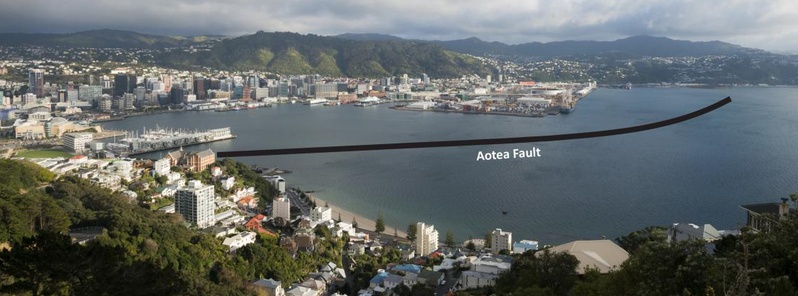New active fault found in Wellington Harbour, New Zealand

NIWA scientists have found a new active fault in Wellington Harbour after analysing data from a recent marine survey. The fault, referred to informally as the Aotea Fault, runs in a northeasterly direction for about 2km in Lambton Harbour, petering out about 1 km east of Westpac Stadium.
The Aotea Fault is part of a series of several dozen geological faults in the Wellington region, many of which are considered capable of generating a strong earthquake.
NIWA marine geologists Drs Philip Barnes, Scott Nodder and Susi Woelz mapped the fault using geophysical techniques as part of the It’s Our Fault research programme led by GNS Science.
The newly identified fault formed a scarp about 1 m high on the seafloor and is thought to be capable of moderate to large earthquakes in the order of magnitude M6.3 to M7.1. It has not yet been identified on land but Drs Barnes and Nodder believe it may extend to the south coast of Wellington and beyond into Cook Strait. They believe at least two significant earthquakes have occurred on the fault in the last 10 000 years.
GNS scientist Russ Van Dissen said the fault did not appreciably increase the overall ground-shaking hazard in Wellington.
“Any ground-shaking that this fault could produce is already considered in Wellington’s seismic hazard calculations. So it is already accounted for in the building code,” he said.
When seismologists estimate seismic hazard for a region they typically add ‘floating faults’ to their calculations as their knowledge of all earthquake-producing faults is imperfect.
This ‘headroom’ in the hazard calculations allows for faults that may be hidden or have poor surface expression. The newly identified fault was a good example of such a fault which scientists occasionally found when analysing geological data.
“It is important to work out its exact location and ground rupture size so this can be incorporated into land use and engineering strategies to mitigate this hazard,” Dr Nodder said.
In the meantime, ongoing research for Greater Wellington Regional Council is also being carried out on the Evans Bay Fault, which is a possibly active fault north of Rongotai in central Evans Bay, first identified over three decades ago.
Source: NIWA
Featured image: Aotea Faultline shown in Wellington Harbour. Credit: NIWA

Commenting rules and guidelines
We value the thoughts and opinions of our readers and welcome healthy discussions on our website. In order to maintain a respectful and positive community, we ask that all commenters follow these rules.